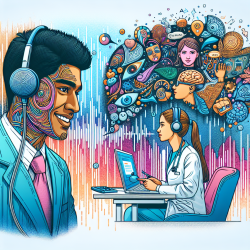In the evolving landscape of education, particularly within the special education sector, the advent of telehealth has marked a revolutionary shift. This transformation is not just about integrating technology into our educational practices; it's about reshaping the way we think about accessibility, efficiency, and effectiveness in providing essential therapy services to students in need. As special education directors and funding agencies, you are at the forefront of this pivotal change. This blog aims to explore the transformative power of telehealth in special education and why it's imperative to take the next step with companies like TinyEYE leading the charge.
Telehealth, in the realm of education, offers a unique blend of flexibility and accessibility, breaking down the traditional barriers that have limited the reach of specialized therapy services. For students requiring speech, occupational, or physical therapy, the geographical and logistical constraints that once posed significant challenges are now being overcome through innovative online therapy solutions. This is not just about bringing services to remote or underserved areas; it's about redefining the therapy experience to make it more personalized, engaging, and effective for each student.
One of the critical advantages of telehealth in special education is the ability to attract and retain highly qualified therapists. The field of online therapy jobs has seen substantial growth, providing an opportunity for specialists to extend their expertise beyond geographical limitations. This growth benefits schools and students by ensuring access to top-tier professionals who are passionate about making a difference in the lives of children with special needs. The traditional model of onsite therapy has its merits, but the flexibility and broader reach of telehealth cannot be understated. It allows for a more diverse pool of therapists, each bringing their unique skills and perspectives to the table, thereby enriching the therapeutic experience for students.
Moreover, the innovation that telehealth brings to special education extends beyond mere convenience. It's about creating a more engaging and interactive learning environment for students. Digital platforms and tools designed for online therapy are often more appealing to students, capturing their attention and interest in ways that traditional methods may not. This engagement is crucial for students with special needs, as it can significantly enhance their motivation and progress in therapy. Through interactive games, virtual reality scenarios, and other digital resources, telehealth services like TinyEYE are making therapy sessions more dynamic and enjoyable for students, leading to better outcomes.
For special education directors and funding agencies, the implications of telehealth are profound. It represents an opportunity to optimize resources, expand service offerings, and most importantly, improve student outcomes. By embracing telehealth, schools can provide more consistent and frequent therapy sessions, monitor progress more effectively, and facilitate smoother collaboration between therapists, teachers, and parents. This integrated approach not only enhances the quality of special education but also contributes to a more inclusive and supportive learning environment for all students.
However, the transition to telehealth is not without its challenges. Concerns regarding data privacy, the digital divide, and ensuring the quality of online therapy are valid and require careful consideration. Yet, with the right policies, technology infrastructure, and training, these challenges can be effectively managed. Companies like TinyEYE are at the forefront of addressing these issues, ensuring that their telehealth services are secure, accessible, and of the highest quality. Their commitment to innovation and excellence in online therapy makes them an ideal partner for schools looking to make this transformative leap.
As we look to the future, the role of telehealth in special education is poised for even greater expansion. The ongoing advancements in technology and digital learning tools will continue to enhance the effectiveness and reach of online therapy services. For special education directors and funding agencies, now is the time to act. By investing in telehealth, you are not just adopting a new method of service delivery; you are embracing a vision of education that is more inclusive, equitable, and capable of meeting the diverse needs of every student.
The journey towards self-actualization for students with special needs is a collaborative one. It requires the commitment of educators, therapists, and policymakers to explore and implement innovative solutions that can truly make a difference. Telehealth represents one of the most promising avenues for achieving this goal. By taking the next step with telehealth, you are not only enhancing the quality of special education but also empowering students to reach their fullest potential.
In conclusion, the revolution of telehealth in special education is not just a trend; it's a testament to our collective commitment to innovation, accessibility, and excellence in education. As special education directors and funding agencies, your role in this transformation is crucial. By embracing telehealth and partnering with leaders in online therapy like TinyEYE, you are paving the way for a brighter, more inclusive future for all students. The time to act is now. Let's take this next step together, for the benefit of our students, our schools, and our communities.










